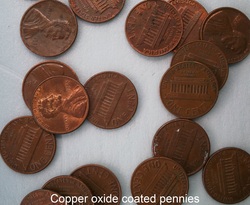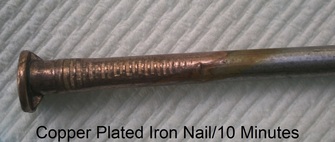

Upcoming posts: Ultrasonic cavitation, Cold cathode lighting, and a really cheap Digital counter.
| Observations |
|
 Autocatalytic deposition of a metal in ionic solution is sometimes called electroless plating. In this case we will be plating copper onto an iron surface without any electricity. The process has been around for a long time and has many interesting applications. In this experiment we will use 1/4 cup of distilled white vinegar, and 1 teaspoon of regular salt and dissolve with stirring. The salt is added to the vinegar (5% Acetic acid) to provide more of an electrical carrier. (More conductive). Old pennies that have reacted with the air over time form copper oxide on the surface. Copper without the oxide is bright and shiny. If you place about 10 old dull pennies in the vinegar, the oxide will be removed and the pennies will be bright. The copper from the copper oxide that has been removed is now in ionic form, not as the metal. This makes it chemically available to plate out on iron. Leave the pennies in the solution for about 5 minutes then remove and rinse. Note: If you leave a couple of the pennies wet with the solution, they will form a green "patina" in about an hour, which is an accelerated form of copper oxide. Place an iron nail or other piece of iron in the solution for about 30 minutes. You will see the copper actually plating out on the surface of the iron. Shiny screws, nuts, and washers fail to work as they are bright and have been coated with zinc (galvanized) to prevent rust. So, you really need plain iron.  This experiment is a fairly simple demonstration of electroless plating. But, the process used in industry is much more complicated and involves a lot of "secret" protected chemistry. It is used extensively for plastics which are not conductive at all. They are "seeded" with a conductive chemical and then copper plated with a strike coat. This is just enough to make them conductive and can then be plated with other metals such as chrome or nickle. Enjoy... Upcoming posts: Ultrasonic cavitation, Cold cathode lighting, and a really cheap Digital counter.
2 Comments
Erik
10/8/2016 06:29:48 pm
Would you expect that wiping the ionic copper solution over a bare, ungalvanized steel surface would achieve a noticeable effect? Perhaps with multiple coats? Do you think using a stronger acid, like H2SO4, would enhance the effect?
Reply
Ken
10/9/2016 04:33:30 pm
Hi Erik,
Reply
Leave a Reply. |
AuthorThe author has an eclectic background in chemistry, electronics, writing, mental health, and community action...Ken Archives
June 2021
|